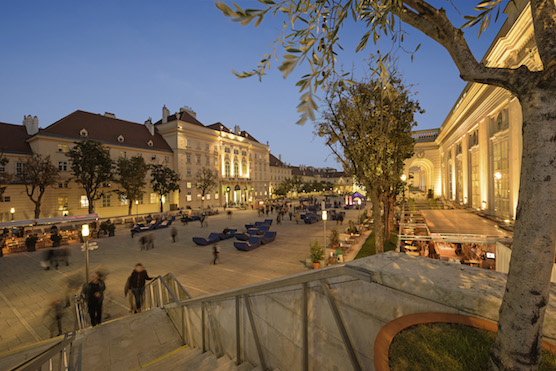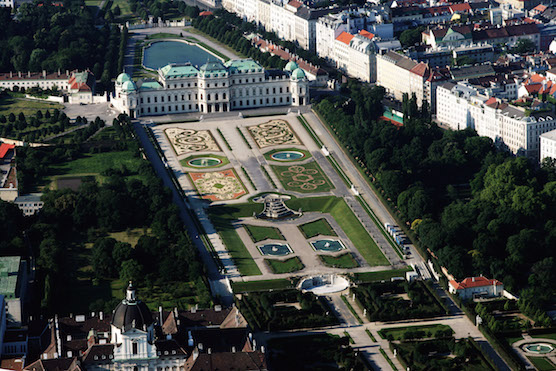Vienna is the city of imperial decadence, fin de siècle debauchery and outlandish contemporary art. The former capital of the Austro-Hungarian Empire, Vienna remains one of Europe’s most cosmopolitan cities—and luckily for its 1.8 million inhabitants, it is regularly ranked in the top three of the world’s most livable cities. The historical home of philosophy, the famous Sacher-Torte, and cafe culture is an easy place for a two-day trip.
The best way to get the most of the city is to use the City Bike program, with 120 stations across the city to pick up and drop off. In addition, the U-Bahn, a subway with 6 lines, will get you anywhere you need to go.
Day One
Morning
Considering that Vienna was among the first European cities to open a café—in the 17th century—UNESCO included Viennese coffee house culture in the national inventory of intangible cultural heritage.
If you’re arriving from Vienna on the fast airport train (CAT), make your first stop Café Pruckl for a proper Viennese coffee and breakfast. They’ve been serving up coffee, croissants, cakes and other delights for more than a hundred years. The interior was last renovated in the 1950s and it is undeniably retro chic. Try Austrian specialty strudel, or an apricot tart, which pairs nicely with the signature vienna coffee, a Wiener Melange, which is like a cappuccino. While you could sit in a Viennese coffee house all day undisturbed, don’t get too comfortable; there’s much more to see.
The locus of Vienna is the old city. Once surrounded by high walls to keep Turkish invasions at bay, it is now known as the Ringstrasse, or Ring street. In its center are the oldest parts of the city. Most things to see will be within the Ringstrasse or the second circle, the Gurtel.
From Pruckl you can walk or cycle around the ring to the Stadtpark. Right on the edge of the circle, this was Vienna’s first municipal park. Opened in 1862, the city park features monuments of Austrian’s elite. A stroll through allows you to pay homage to famous Austrian composers Johann Strauss and Franz Schubert.

Photo courtesy of WienTourismus/W. Hofmann
Follow the road past the iconic Vienna State Opera, and then hang a right to wend your way to Stephansdom (pictured above), a 14th century Gothic mega-church, where the best things to see are above and below. The crypt and catacombs underneath the building contain the bodies of Viennese who succumbed when the bubonic plague decimated the city’s population in the 18th century. There are also some former Holy Roman Emperors buried here. At the top of the church you can see a magnificent view of the whole city.
Afternoon
For lunch, try some typical Austrian foods. Right by the cathedral, Figlmueller serves up their specialty, a tradition more than 100 years old: Wiener Schnitzel. In Viennese tradition, the veal cutlet is pounded, breaded and fried, and most importantly, larger than your plate.
It’s time for a pick-me-up and some dessert. Head toward the Hofburg and pop in to Café Hawelka, where the “only concession to modernity is an espresso machine.” Try the apfel (apple) strudel before making your way to the Hofburg Palace, which served as an imperial residence from 1279 until after WWI. It is all done up in Habsburg style, with turquoise domes, royal portraits and gilded halls.
If you’ve had enough of the chintzy lifestyle, pass the museums abutting the palace complex and carry on toward the Naschmarkt. There are more than a hundred stands offering local and international delicacies, and browsing for chutneys, cured meats, and freshly baked bread is a joy. But on Saturdays the real excitement is at Floh Markt, or Flea Market. If you are in Vienna on the weekend, take some time to indulge in the varied offerings at this market and listen to the mashup of languages spoken by the vendors.
Coming back through the Naschmarkt, marvel at the Majolica House, a renowned art deco complex on Linke Wienzeile Street. Then check out the blazing golden dome of the nearby Vienna Secession, the beautiful product of turn of the century artists rebelling from the Austrian Academy of Arts. The small museum captures the spirit and the art of the era.

Photo courtesy of WienTourismus/Christian Stemper
If you’ve got time, walk back to the MuseumsQuartier (pictured above). The twin museums of Art and Natural History have rich offerings, but the place to be is the Leopold Museum, which has a great collection of modernist art with an emphasis on Viennese fin de siècle—turn of the century—artists, including Egon Schiele and Gustav Klimt. If you are looking for something even more avant-garde, head to the MUMOK, a modern art museum that features Picasso and other greats, but also more contemporary pieces that shock visitors.
Evening
Time to eat. Magazin Drei Hacken is less touristy than other restaurants in central Vienna and makes local specialties like Bratwurst with Sauerkraut. Try the Fiakergulasch with dumplings, fried egg, sausages and pickles, or the beef with apple horseradish—a regional specialty.
Post-feast, catch a show at the jazz club Porgy & Bess, which has fantastic jazz, blues and world music concerts almost every night, usually for under 20 euros per ticket (1 EUR = $1.1). On a recent visit, a jazz Tuba player jammed for three hours with an Austrian saxophonist and a bass guitarist from Philadelphia.
If you’ve still got more energy, head to FLUC, a club built in a former pedestrian arch at the Prater metro stop, or B72, where you can dance to electronic music late into the night.
Photo by Ulli Michel/Getty
Day Two
Morning
If you’re loving the old fashioned vibe, head to Café Sperl for an elegant breakfast of bacon and eggs, or a simple pastry. Take this time to savor a classic einspanner—coffee with fresh whipped cream. Café Sperl was a favorite of musician Johan Strauss and also Adolf Hitler. If you’d prefer a place patronized by Leon Trotsky, go to Café Central and dine under its meticulous marble arches.
Then, for a bit of contrast, set out for Kunst Haus Wien, a museum dedicated to the life and work of Viennese artist Friedensreich Hundertwasser. Not your average stuffy art museum, the outside is painted red, white and purple and inside the floor is bumpy because the artist believed that “an uneven floor is a melody to the feet.” On display are Hundertwasser’s trippy prints and models of his vision of environmentally conscious communities.
For lunch, you can have a coffee and locally-sourced vegetarian dish in the downstairs TIAN Bistro. Try their specialty, a tarte flambee—thinly rolled dough with crème fraiche topped with local cheese, leeks, and onion.
Afternoon
No trip to Vienna is complete without visiting the Belvedere Palace and Museum (pictured at top). The institution features a collection of artwork by Gustav Klimt, as well as work by Van Gogh and Monet.

Photo courtesy of WienTourismus/Claudio Alessandri
When you’re finished, take the U-Bahn to Praterstern in the Leopoldstadt District and walk over to the Riesenrad, which until 1985 was the world’s tallest Ferris wheel. For a breathtaking view, ride the wheel to the top and hope to get stuck. If heights aren’t your thing, admiring the beast from below is still a treat.
Afterward, walk down Lasallestrasse to the river and over it. Donauinsel—Danube Island— is a 13-mile island in the middle of the Danube River. Enjoy some some strolling, cycling, swimming, sunbathing, and of course, eating and drinking. Check out the river “beach” at Arbeiterstrandbad or rent a paddleboat until midnight to visit the swans in the park.
Evening
For fresh fish with a view, visit Zur Alten Kaisermühle on the island and try the grilled char. Then hit up one of the chic cafes or bars like Sunken City, which hosts seasonal musical festivals.
Go for a final Viennese drink at Schadekgasse 12, the name and address of a hip cafe/bar in the Mariahilferstrasse shopping district. If you’re feeling patriotic, check out the tiny Belle Epoque Loos American Bar on the Karntner ring.
Getting There
Vienna International Airport is a global hub with nonstop flights from 154 cities. Austrian Airlines has direct flights from New York and Washington.
Where To stay
Hostel Ruthensteiner boasts a lovely garden and is conveniently located near a train station and the hip Mariahilf shopping district. Beds start at 18 euros ($20) per night.
For the creative type, the Hotel Urania offers themed-rooms like “Safari,” “Knights,” and “Goldfinger.” Rooms start at 95 euros ($105) per night.
Pansion Pertschy’s location cannot be beat. Right next to the Hofburg Palace, this boutique hotel is in the center of the city. Single rooms start at 110 euros ($120) and double rooms start at 150 euros ($170) per night.
Valerie Hopkins is a journalist based in Prishtina, Kosovo.